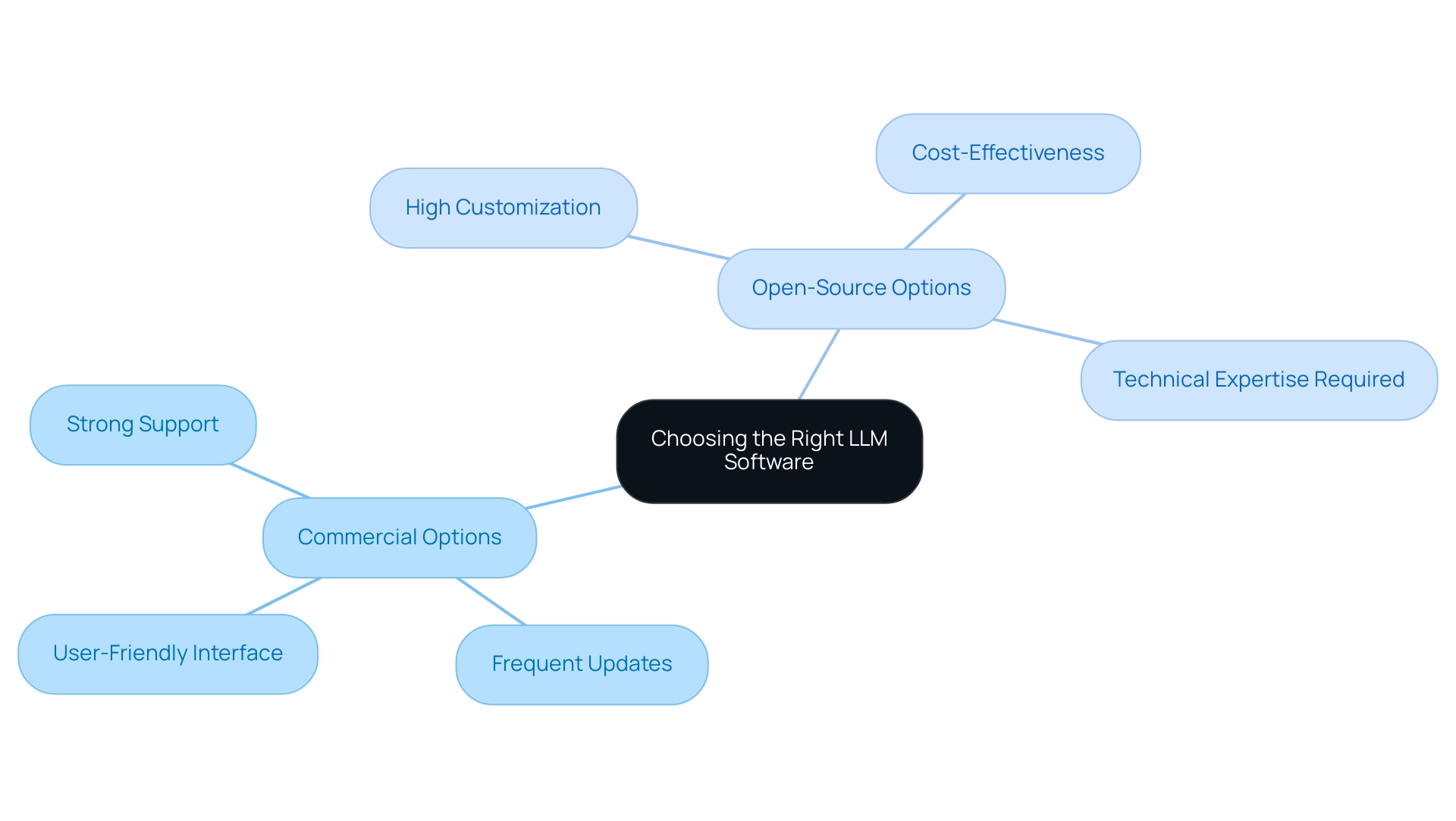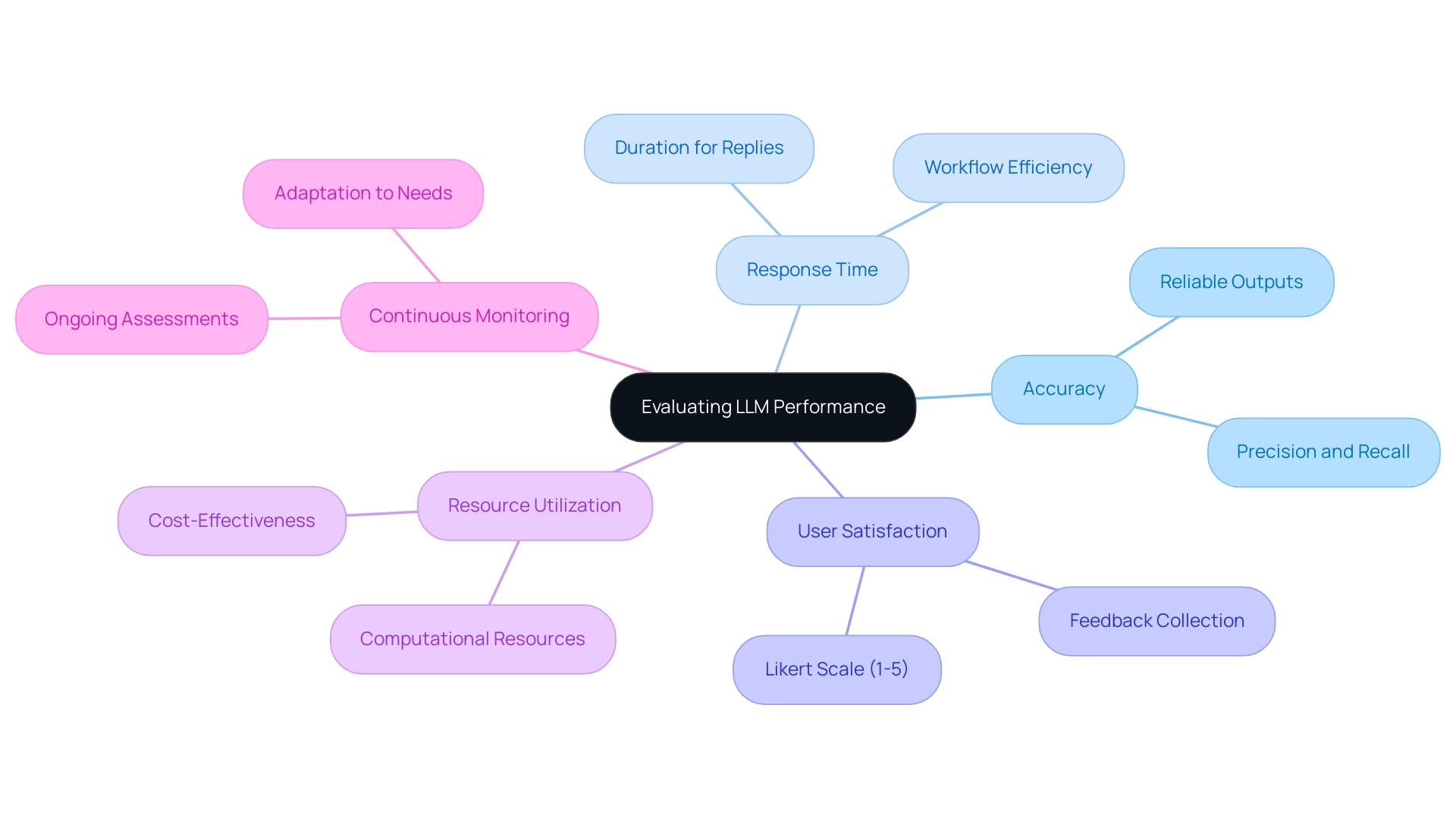Introduction
In the rapidly evolving landscape of technology, Large Language Models (LLMs) are revolutionizing the way software development is approached. These sophisticated AI systems not only understand and generate human-like text but also empower developers to automate complex tasks, streamline workflows, and enhance collaboration. The integration of tools like Kodezi exemplifies this transformation, offering programmers the ability to effortlessly generate code and improve code quality with unparalleled efficiency.
As organizations increasingly recognize the value of LLMs, the potential for productivity gains becomes evident, with reports indicating improvements ranging from modest to extraordinary. This article delves into the critical aspects of LLMs, from selecting the right software to best practices for implementation and ongoing maintenance, providing insights that can redefine the future of software engineering.
Understanding Large Language Models: Definition and Importance
Large Language Models (LLMs) represent a significant advancement in AI, meticulously engineered to comprehend and generate human-like text from given inputs. These models leverage vast datasets and intricate algorithms to discern language patterns, empowering them to accomplish a wide range of tasks—including:
- Text generation
- Summarization
- Translation
- Code generation
Tools like CLI and Code exemplify this capability, functioning as a Swiss-Army Knife for programmers and allowing teams to auto-heal codebases in seconds and automate code generation from PDF instructions with a simple drag-and-drop functionality. With this tool, you can generate code with the click of a button—just input your question and let the AI do the rest.
For developers, mastering large language models and tools like Kodezi is essential as they can dramatically boost productivity by:
- Automating routine tasks
- Enhancing code quality
- Fostering clearer communication within teams
The idea of 'attractor sequences' demonstrates that even slight changes in input can result in strikingly similar outputs, highlighting the dependability of large language models. Albert Einstein once said,
'Concerning matter, we have been all wrong. What we have called matter is energy, whose vibration has been so lowered as to be perceptible to the senses. Matter is spirit reduced to point of visibility.'
This perspective resonates with the transformative potential of large language models in reshaping software development.
In practical terms, recent reports by Dave Blundin indicate that portfolio companies have witnessed productivity improvements ranging from 5% to an astonishing 20% by integrating these models and tools like Kodezi. Additionally, advancements in large language models now include enhanced contextual understanding and more efficient training methods, making them increasingly accessible and effective.
As we approach 2024, trends suggest an increasing use of large language models and tools across multiple sectors, with organizations acknowledging their ability to enhance workflows and reduce manual effort. By facilitating innovation in application development, LLMs and another platform not only redefine the potential of the engineering process but also indicate a future of greater efficiency and effectiveness in projects, ensuring you never waste time on a pull request again.
Choosing the Right LLM Software: Commercial vs. Open-Source Options
When choosing LLM applications, it's essential to consider both commercial and open-source options. While commercial applications such as OpenAI's GPT models or Anthropic's Claude provide strong support and frequent updates, this platform distinguishes itself by improving your coding skills with its user-friendly interface and distinctive features. With this tool, you can experience a seamless coding process that boosts productivity and efficiency.
Open-source alternatives like Hugging Face's Transformers or Google's BERT provide high customization and cost-effectiveness, but may require more technical expertise. To find the best fit for your team’s needs and budget, assess the level of support required.
Don't forget to explore the platform's offerings—get started for free or schedule a demo today to see how it can transform your development and testing experience!

Implementing LLM Software: Best Practices for Integration
To maximize the effectiveness of LLM applications, it is essential to start with a thorough assessment of your current workflows, pinpointing areas where the model can deliver significant value. Applying the following best practices will simplify the process and improve your coding skills with the platform:
- Pilot Testing:
Initiate a pilot project to assess the program's performance in a controlled setting. This critical step allows for necessary adjustments before a full-scale rollout, significantly improving implementation success rates. For instance, studies have shown that organizations that conduct pilot testing see success rates increase by up to 30% compared to those that skip this phase. With this platform, you can Get Started for Free to explore these benefits. - Integration with Existing Tools:
Ensure seamless integration of the LLM application with your current development tools and platforms. Doing so minimizes disruptions, enhances collaboration, and leverages existing workflows to their fullest potential. The platform's integration capabilities make this process even smoother. Remember, you can always Get a Demo to see how it works in your environment. - Team Training:
Equip your team with comprehensive training on the new system. Familiarity with its capabilities and effective utilization strategies is key to harnessing its full potential. Kodezi offers demos that can help your team get up to speed quickly. Take advantage of our Get Started for Free offer to access training resources. - Feedback Loop:
Establish a robust feedback mechanism to capture user insights. This continuous feedback will help identify challenges and inform areas for improvement during and after implementation. - Documentation:
Maintain meticulous documentation throughout the integration process. Documenting the steps undertaken and modifications applied to workflows will offer a useful reference for upcoming updates and problem-solving.
In the field of software development, incorporating large language models can result in transformative outcomes, especially when supported by thorough pilot testing and user training. As highlighted by Lilian Weng,
Given a company’s all documentations, policies, and FAQs, you can build a chatbot that can respond to your customer support requests.
This illustrates the real-world applicability of large language models in enhancing efficiency and productivity across various operational facets. Additionally, with KodeziChat, you can get answers to any coding question and solve code issues rapidly, thanks to its AI-driven capabilities, reinforcing the tangible benefits and cost-effectiveness of these technologies in real-world applications. Don't forget to Get Started for Free to experience how KodeziChat can transform your coding experience.
Evaluating LLM Performance: Metrics and Benchmarks
To effectively evaluate the performance of large language models (LLMs), consider these essential metrics and benchmarks:
- Accuracy: Assess the precision and recall of the system to determine how accurately it generates or interprets text. Higher accuracy is critical for reliable outputs in software development.
- Response Time: Monitor the duration required for the system to produce replies. Swift response times enhance workflow efficiency and user productivity.
- User Satisfaction: Gather feedback from users to assess their contentment with the outputs. Employing user satisfaction surveys, utilizing the Likert Scale which allows users to rate generated output from 1 (completely irrelevant) to 5 (perfectly fluent), provides a nuanced understanding of real-world performance, highlighting areas for improvement.
- Resource Utilization: Investigate the computational resources the LLM consumes during operation. Efficient resource usage is vital for maintaining cost-effectiveness and scalability in development projects.
- Continuous Monitoring: Implement a systematic approach for ongoing performance evaluation. Regular assessments ensure the LLM adapts effectively to evolving organizational needs and maintains high standards of output quality.
As Ayush Patil, a Trainee Software Engineer, notes, "Let me begin by explaining why understanding evaluation metrics is crucial in 2024!" This perspective underscores the necessity of robust evaluation practices, such as those exemplified by Amazon Bedrock, which simplifies evaluation and deployment of large language models, in optimizing LLM performance and achieving maximum productivity.

Maintaining and Updating LLM Software: Ensuring Longevity and Relevance
To ensure the longevity and relevance of LLM applications, follow these maintenance strategies:
- Regular Updates: Stay informed about updates and new releases from the application provider. Implement updates promptly to benefit from improvements and security patches.
- Monitoring Performance: Continuously monitor the performance of the LLM to identify any degradation in output quality or efficiency. This allows for timely interventions.
- User Training: Provide ongoing training for users to familiarize them with new features and updates. This enhances their ability to utilize the program effectively.
- Community Engagement: Participate in user communities or forums related to the LLM application. This can provide valuable insights into best practices and emerging trends.
- Documentation Updates: Keep documentation updated with any changes made to the software or workflows. This ensures that all team members have access to the latest information.
Conclusion
The integration of Large Language Models (LLMs) into software development represents a paradigm shift that enhances productivity and streamlines workflows. By employing tools like Kodezi, developers can automate complex tasks, generate code effortlessly, and improve overall code quality. The insights shared highlight the critical importance of selecting the right software, implementing best practices, and continuously monitoring performance to maximize the benefits of LLMs.
Choosing between commercial and open-source options requires careful consideration of team needs and available resources, with Kodezi emerging as a standout choice for its user-friendly interface and robust capabilities. Implementing LLMs effectively hinges on pilot testing, seamless integration, and comprehensive team training, ensuring that organizations can harness their full potential. The evaluation of LLM performance through key metrics further underscores the value of these technologies in achieving operational efficiency.
Maintaining and updating LLM software is vital for sustaining relevance and effectiveness in a rapidly changing technological landscape. By following strategic maintenance practices, organizations can ensure that they remain at the forefront of innovation in software engineering. As the adoption of LLMs continues to grow, embracing these advancements will redefine the future of software development, enabling teams to achieve unprecedented levels of efficiency and productivity.
The time to leverage these transformative tools is now, paving the way for a more effective and innovative engineering process.
Frequently Asked Questions
What are Large Language Models (LLMs)?
Large Language Models (LLMs) are advanced AI systems designed to understand and generate human-like text from given inputs. They use extensive datasets and complex algorithms to recognize language patterns.
What tasks can LLMs perform?
LLMs can perform a variety of tasks, including text generation, summarization, translation, and code generation.
How do tools like CLI and Code enhance programming with LLMs?
Tools like CLI and Code allow programmers to automate code generation and manage codebases efficiently, enabling quick fixes and generation of code from simple inputs like drag-and-drop functionalities.
What benefits do LLMs provide for developers?
LLMs can significantly boost developer productivity by automating routine tasks, enhancing code quality, and improving communication within teams.
What is the significance of 'attractor sequences' in LLMs?
'Attractor sequences' illustrate that minor changes in input can yield similar outputs, demonstrating the reliability of large language models.
What productivity improvements have companies experienced by using LLMs?
Companies have reported productivity improvements ranging from 5% to 20% after integrating LLMs and tools like Kodezi into their workflows.
What types of LLM applications are available?
There are both commercial applications, like OpenAI's GPT models and Anthropic's Claude, and open-source options, such as Hugging Face's Transformers and Google's BERT, each offering different levels of support and customization.
What are some best practices for implementing LLM applications?
Best practices include conducting pilot testing, ensuring integration with existing tools, providing team training, establishing a feedback loop, and maintaining thorough documentation.
What metrics should be used to evaluate LLM performance?
Key metrics for evaluating LLM performance include accuracy, response time, user satisfaction, resource utilization, and continuous monitoring for ongoing performance assessment.
What maintenance strategies are important for LLM applications?
Important maintenance strategies include regular updates, continuous performance monitoring, ongoing user training, community engagement, and keeping documentation current.




